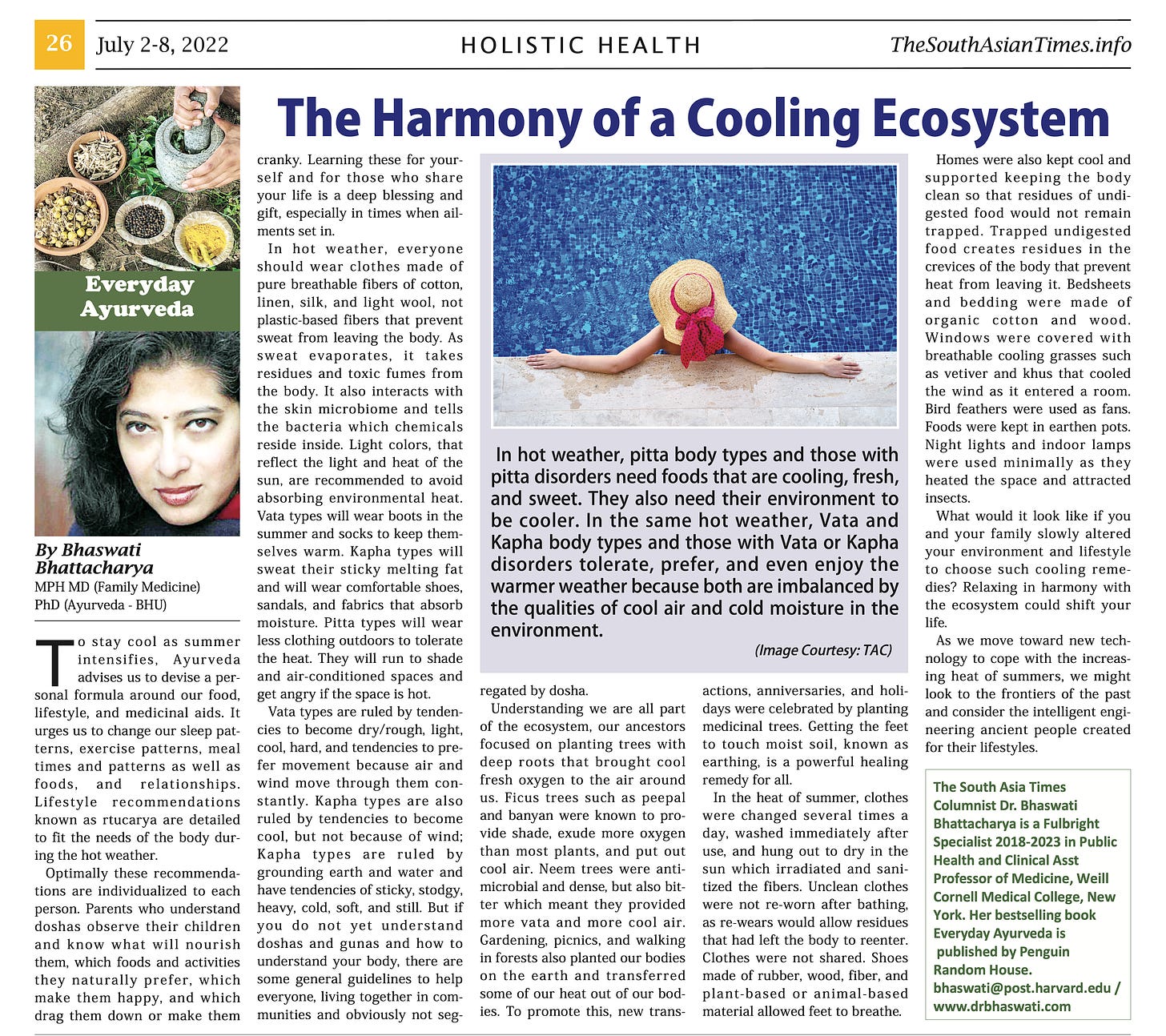Living in Harmony with a Cooling Ecosystem
natural khus grasses woven into curtains transform wind into cool air inside.
To stay cool as summer intensifies, Ayurveda advises us to devise a personal formula around our food, lifestyle, and medicinal aides. It urges us to change our sleep patterns, exercise patterns, meal times and patterns as well as foods, and relationships. Lifestyle recommendations known as ṛtucarya are detailed to fit the needs of the body during the hot weather.
Optimally these recommendations are individualized to each person. Parents who understand doshas observe their children and know what will nourish them, which foods and activities they naturally prefer, which make them happy, and which drag them down or make them cranky. Learning these for self and for those who share your life is a deep blessing and gift, especially in times when ailments set in.
In hot weather, pitta body types and those with pitta disorders need foods that are cooling, fresh, and sweet. They also need their environment to be cooler. In the same hot weather, vata and kapha body types and those with vata or kapha disorders tolerate, prefer, and even enjoy the warmer weather because both are imbalanced by the qualities of cool air and cold moisture in the environment.
All should wear clothes made of pure breathable fibers of cotton, linen, silk, and light wool, not plastic-based fibers that prevent sweat from leaving the body. As sweat evaporates, it takes residues and toxic fumes from the body. It also interacts with the skin microbiome and tells the bacteria which chemicals reside inside. Light colors, that reflect the light and heat of the sun, are recommended to avoid absorbing environmental heat. Vata types will wear boots in the summer and socks to keep themselves warm. Kapha types will sweat their sticky melting fat, and will wear comfortable shoes, sandals, and fabrics that absorb moisture. Pitta types will wear less clothing outdoors to tolerate the heat. They will run to shade and air-conditioned spaces and get angry if the space is hot.
Vata types are ruled by tendencies to become dry/rough, light, cool, hard, and tendencies to prefer movement because air and wind move through them constantly. Kapha types are also ruled by tendencies to become cool, but not because of wind; kapha types are ruled by grounding earth and water and have tendencies of sticky, stodgy, heavy, cold, soft and still. But if you do not yet understand doshas and gunas and how to understand your body, there are some general guidelines to help everyone, living together in communities and obviously not segregated by dosha.
Understanding we are all part of the ecosystem, our ancestors focused on planting trees with deep roots that brought cool fresh oxygen to the air around us. Ficus trees such as peepal and banyan were known to provide shade, exude more oxygen than most plants, and put out cool air. Neem trees were anti-microbial and dense, but also bitter which meant they provided more vata and more cool air. Gardening, picnics, and walking in forests also planted our bodies on the earth and transferred some of our heat out of our bodies. To promote this, new transactions, anniversaries and holidays were celebrated by planting medicinal trees. Get the feet to touch moist soil, known as earthing, is a powerful healing remedy for all.
In the heat of summer, clothes were changed several times a day, washed immediately after use, and hung out to dry in the sun which irradiated and sanitized the fibers. Unclean clothes were not reworn after bathing, as re-wears would allow residues that had left the body to reenter. Clothes were not shared. Shoes made of rubber, wood, fiber and plant-based or animal-based material allowed feet to breathe.
Homes were also kept cool and supported keeping the body clean so that residues of undigested food would not remain trapped. Trapped undigested food create residues in the crevices of the body that prevent heat from leaving it. Bedsheets and bedding were made of organic cotton and wood. Windows were covered with breathable cooling grasses such as vetiver and khus that cooled the wind as it entered a room. Bird feathers were used as fans. Foods were kept in earthen pots. Night lights and indoor lamps were used minimally as they heated the space and attracted insects.
What would it look like if you and your family slowly altered your environment and lifestyle to choose such cooling remedies? Relaxing in harmony with the ecosystem could shift your life.
As we move toward new technology to cope with the increasing heat of summers, we might look to the frontiers of the past and consider the intelligent engineering ancient people created for their lifestyles.
week 117. TheSouthAsianTimes
Download the .pdf version of this column by clicking on the image.
Dr. Bhaswati Bhattacharya is a Fulbright Specialist 2018‐2023 in Public Health, a family physician in the Department of Medicine at Weill Cornell Medical College in New York, NY, and holds doctorates in pharmacology and Ayurveda. She teaches ayurvedic nutrition on global platforms and cleans her channels regularly with sesame oil, mustard oil, and ghee.
Her bestselling book Everyday Ayurveda is published by Penguin Random House.
To order an autographed copy, write to bhaswati@post.harvard.edu.
To learn more, visit www.drbhaswati.com





